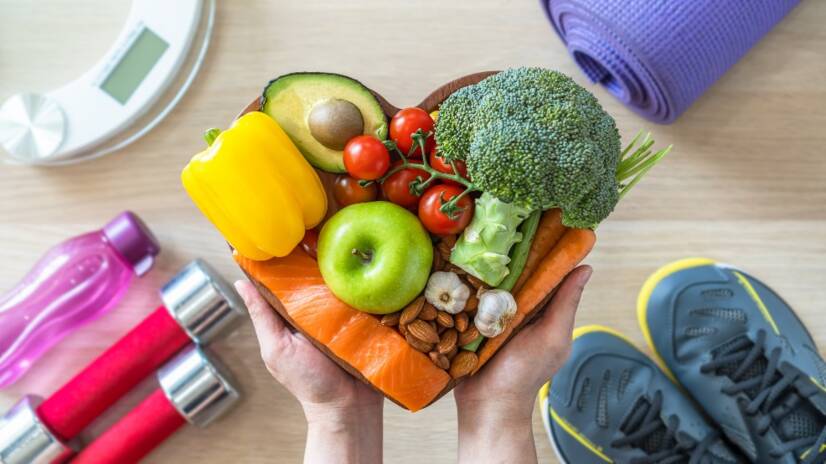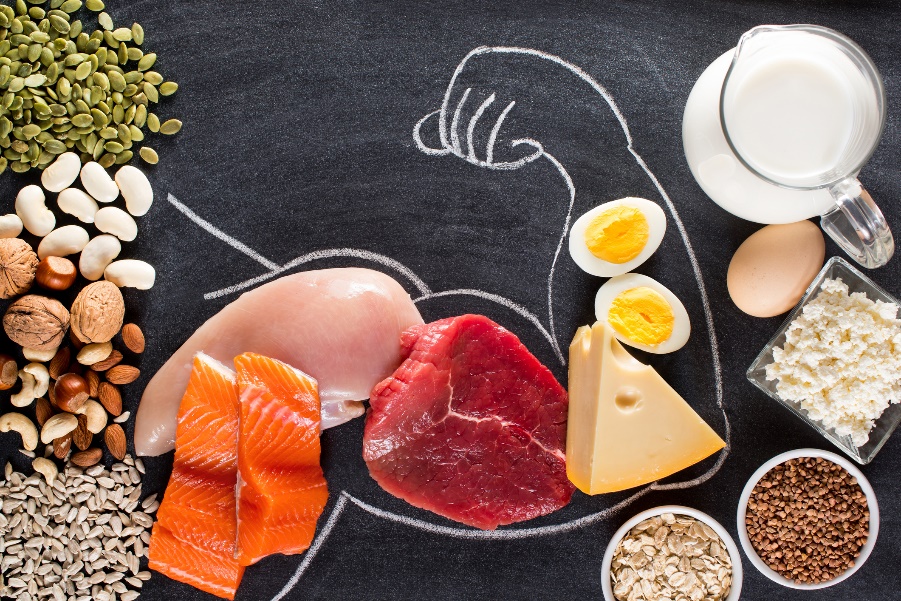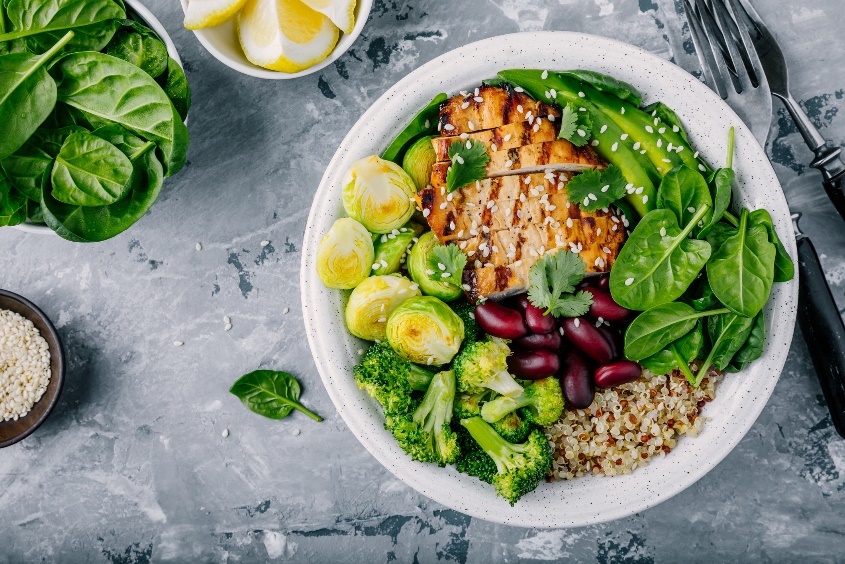- DAHLKE, Rüdiger. How to eat right: a holistic path to healthy eating. Olomouc: Fontána, c2007. ISBN 978-80-7336-366-6
- KOHOUT, Pavel, Eduard HAVEL, Martin MATĚJOVIČ and Michal ŠENKYŘÍK, ed. Clinical nutrition. Prague: Galén, [2021]. ISBN 978-80-7492-555-9
- healthline.com - What Are Macronutrients? All You Need to Know. Healthline. Amy Richter, RD
- betterhealth.vic.gov.au - Weight loss - a healthy approach. Better Health Channel
How to lose weight at home and healthy? Appropriate diet, exercise and dietary supplements

Weight loss and body shaping is a common part of a lifelong lifestyle. A healthy diet, regular physical activity and a few effective tips do wonders for the body. How to do it in a home environment?
Article content
It's important to remember from the outset that the foundation of healthy and sustainable weight loss is a regular, balanced diet. While this may sound like a cliché, it's the only way to make weight loss challenging and at the same time free of health risks.
Along with exercise, an individual can effectively shed excess pounds. You can learn about diet, calorie deficit, appropriate physical activity, supplements and many other interesting information in this article.
Calorie deficit: the key to success
The energy we take in during the day in the form of food is energy expressed in calories (kcal). We also give off energy daily in the form of basal metabolic rate and physical activity.
Basal metabolism is determined by age, gender, height, weight, health, genetic factors and long-term lifestyle. It is the energy the body processes each day to function properly.
Added physical activity is work activity, home physical activity (cleaning), sports and other physical activities.
If energy expenditure is greater than energy intake, weight loss occurs. If calorie intake is greater than our body can burn, we gain weight.
- Various crash diets that promise early results are based on a significant calorie deficit. However, this is not sustainable and healthy in the long term.
- Diets that exclude certain macronutrients (carbohydrates, fats) from the diet are also not sustainable in the long term. They can cause insufficient intake of needed nutrients.
Therefore, it is important that the diet contains all macronutrients (protein, fat, carbohydrates) and that the caloric deficit is moderate. Consequently, weight loss will be healthy, sustainable without health risks and yo-yo effect.
Weight loss healthy = sustainable = no health risks = no yo-yo effect...
To get a better idea of your daily expenditure, it is advisable to use an online calculator to approximate your basal metabolic rate (basal caloric expenditure without added physical activity).
You can find out your calorie expenditure on food packaging or by using online calorie tables or a simple mobile app.
Beware of becoming a slave to numbers and math.
Daily calorie requirement calculator
Useful tools:
- Calculator.
- Target Weight Calculator Lose weight, gain weight, maintain weight?
- BMR - Basal Metabolic Rate Calculator
- Calculator: How to convert kJ and kcal?
- Calorie tables: what are the nutritional/nutritional values of meals, foods?
Calculator - target body weight
Appropriate diet is the foundation
As mentioned above, the diet taken should contain protein, carbohydrates, fats and sufficient fibre intake. It should be regular, balanced and combined with adequate drinking.
Essential nutrients in the human diet: what are proteins, sugars, fats?
In the context of weight loss and body shaping, it is advisable to increase the intake of protein and, conversely, reduce the intake of fast carbohydrates and unhealthy fats.
But what does this mean in practice?
Carbohydrates - essential for energy and performance
One gram of carbohydrates contains 4 kcal.
Carbohydrate intake is essential for sufficient energy, performance, daily work activities, sports activities, etc. It is the so-called fuel of the body.
Increased carbohydrate intake is especially suitable for athletes.
Their intake is important for the body and it is not advisable to exclude them from the diet. However, when reducing weight, it is necessary to consider their quantity in relation to the energy expenditure during the day. In general, it is recommended that complex slow carbohydrates account for 40 % of the daily intake.
Excessive amounts of carbohydrates are not advisable for weight loss, especially fast carbohydrates - sugars that do not have a satiating effect but are also high in calories.
Example of a source of complex carbohydrates in the diet:
- Pasta
- Rice
- Potatoes
- Quinoa
- Beans
- Couscous
- Wholemeal bread
- Chickpeas...
Fats - needed for energy and hormonal activity
1 gram of fat contains 9 kcal.
Fats (lipids) are a high source and reservoir of energy that covers the body's energy needs. They are important for hormonal activity and balance. It is generally recommended that fats make up 20% of daily intake.
Higher amounts are not recommended for weight reduction.
Example of a source of suitable fats in the diet:
- Olive oil
- sunflower oil
- avocados
- butter
- fatty fish (salmon, mackerel)
- eggs
- nuts and seeds
- cheese
- milk
- cream
Protein - the basic building blocks of the body needed to maintain muscle mass
1 gram of protein contains 4 kcal.
In the human body, proteins have countless important functions: metabolic transport, structural functions, biochemical transformations or regulation of the internal environment.
They are an essential building block for skeletal muscle formation and muscle building.
Protein has a high satiating effect. It is generally recommended that complex slow carbohydrates make up 30% of daily intake.
The basic protein intake for adults is set at 0.8 g of protein per 1 kg of body weight. In cases of weight reduction and body shaping, it is advisable to increase the intake to 1.5-2 g per 1 kg of body weight.
Example of a source of protein in the diet:
- meat (especially chicken, beef)
- eggs
- cottage cheese
- cottage cheese
- cheese
- milk
- chickpeas
- beans
- fish
- lentils
- tofu

Drinking regime
About two-thirds of our body is water. Most biochemical processes take place in an aqueous environment. Water helps transport nutrients and substances into the body and subsequently helps to eliminate metabolites and pollutants from the body.
We need to ensure that we have sufficient fluid intake every day so that our body can function physiologically.
A suitable source of fluids is e.g:
- pure water
- mineral water
- fruit and herbal teas
- fresh juices
In the context of weight loss, beware of liquid calories - sweetened carbonated sodas with high calorie content, fast sugar and minimal satiating effect.
Calculate your daily fluid intake:
Drinking plan - calculator: How much water should I drink a day?
Fiber
Fibre is important for the proper functioning of the digestive tract and for promoting regular bowel movements. It acts on the intestinal microflora as a probiotic. It has a filling and satiating effect. It is an important source of energy and essential nutrients.
Daily intake should be 20-35 g of fibre.
Example of a source of fibre:
- Cereals
- Vegetables
- Fruits
- Whole grain bread
- Whole grain pasta
- Muesli
- Oatmeal
Homemade food preparation
Although preparing meals at home may seem tedious to some, this is not the case. Many healthy and wholesome recipes are ready in minutes.
Eating at home has many advantages. The biggest one is the knowledge of the food. You know yourself what quality and quantity of products you are buying. Another advantage is the economic aspect of saving money and not having to eat in restaurants.
Last but not least, you can cook food that suits your taste to the last detail.
If you prepare all your daily meals at home, you can always cook a little more. When cooking a larger meal, you can then divide it into several portions in boxes (with a side dish or a small variation if necessary).
Below are a few examples of a daily diet. However, please note that the exact amount depends on your energy intake, expenditure and goal.
Breakfast example:
- Protein pudding with oatmeal and a small amount of nuts
- Oat protein porridge with fruit and a small amount of nuts
- Scrambled eggs/omelet with fresh vegetables
- Mozzarella with tomatoes, olives and rocket
Lunch/dinner example:
- Grilled chicken with rice and cooked vegetables
- Roasted chickpeas with quinoa and raw fresh vegetables
- Grilled halloumi cheese with vegetable salad
- Pasta with tomato sauce and ground beef
- Grilled salmon with asparagus and vegetable/potato salad
- Tortilla baked with chicken/beans and vegetables
Example of appetizer/dessert:
- Cottage cheese/low-fat cottage cheese
- Protein drink/pudding/snack
- Fruit (apple, banana, berries...)
- Vegetable/fruit smoothie
Tips for weight loss and diet modification:
- Find out your approximate energy intake and expenditure
- Moderate calorie deficit of 10-15%
- Eat regularly and at a slower pace
- Do not eliminate any macronutrient from your diet
- Increase vegetable and fiber intake
- Increase protein intake in your diet
- Eliminate excessive intake of fats and sugars
- Eliminate liquid calorie intake
- Maintain an adequate drinking regime
- Beware of tricky calorie-dense dressings and sauces
- Beware of excessive side dishes and low protein
- Eat appropriate foods that you enjoy and don't force yourself to eat others
- Combine a modified diet with physical activity

Appropriate physical activity
In the context of weight loss, it is advisable to choose aerobic endurance exercise/sports. Conversely, in the context of body shaping and firming, it is advisable to choose anaerobic/strength exercises.
The golden mean is a combination of both types of physical activity. However, beware - by completely skipping "strength" training, one may not be satisfied with the results despite weight reduction. It is the muscle mass that shapes the physique.
Cardio training
During endurance exercise, the function of the cardiovascular system is improved. Many calories are burned because fat is used efficiently as the main source of energy.
These include long distance running, cycling, swimming, fast walking, skating, etc. Cardio training in a home environment is more challenging to perform if you do not have a stationary bike or treadmill.
However, if you have enough space at home, cardio training can be done by following proven internet videos and tutorials. These are mainly jumping, dancing and running exercises in a small space.
Read also:
What is cardio training? Is cardio exercise suitable for everyone?
Strength training
Anaerobic exercise is an activity with higher intensity and shorter duration. Apart from strength training itself, this includes interval running, sprinting and spinning.
Strength training with your own weight is suitable for beginners, and it is advisable to use different weight training equipment and dumbbells as part of the progression.
However, if you do not want to spend time in the gym and want to progress, it is advisable to use some of the exercise equipment in addition to the mat:
- Resistance bands (booty-bands)
- Overball, fitball
- Kettlebell
- Dumbbells
- Sand weights for limbs
HIIT training
This type of training is mainly characterised by alternating intervals of high intensity followed by an interval of rest. It can be composed of various exercises (dynamic, endurance, strength) or in the form of circuit training.
A popular form of HIIT training is, for example, the tabata system, which combines short periods of intense exercise with short phases of rest or lower intensity exercise. HIIT (high intensity interval training) can also be performed in the home.
Due to the higher intensity of the exercise, the subsequent recovery period after exercise is also demanding and more energy is consumed.
We recommend that you turn to proven training videos that can be used to train comfortably at home - whether for strength or endurance.
You can also find information in the following article:
High Intensity Interval Training - HIIT. What effect does it have on our body?
Body weight training. Is it possible to do it at home?

Dietary supplements for weight loss
Hand in hand with crash diets and detoxes, there are many different dietary supplements on the market today to promote weight loss. The products promise fast effective weight loss without much effort.
However, this is not true - beware of overpriced drinks, detox products, diet pills that are neither healthy nor sustainable in the long term.
However, there are certain proven dietary supplements that could help you achieve your desired goal.
Dietary supplements referred to as fat burners are another aid and the so-called icing on the cake in the weight loss process. Without a calorie deficit in the diet, it is impossible to achieve the desired results.
Fat burners can motivate an individual and help him or her towards his or her goal. However, it is not recommended to buy the products without dietary modification and physical activity - it would be money wasted.
In most cases, fat burners contain substances such as synephrine, L-carnitine and the supporting substances caffeine or green tea extract.
In the context of dietary supplements, it is worth mentioning the protein powder drink, which is low in calories, has a high protein content and a strong satiating effect. At the same time, it "deceives" the body when craving for sweets.
It is a suitable choice for people who have difficulty in getting the necessary amount of protein in their diet. It can also replace a snack or afternoon snack.
Healthy weight loss for women? Appropriate diet and exercise. Truths and myths about weight loss
Interesting resources










